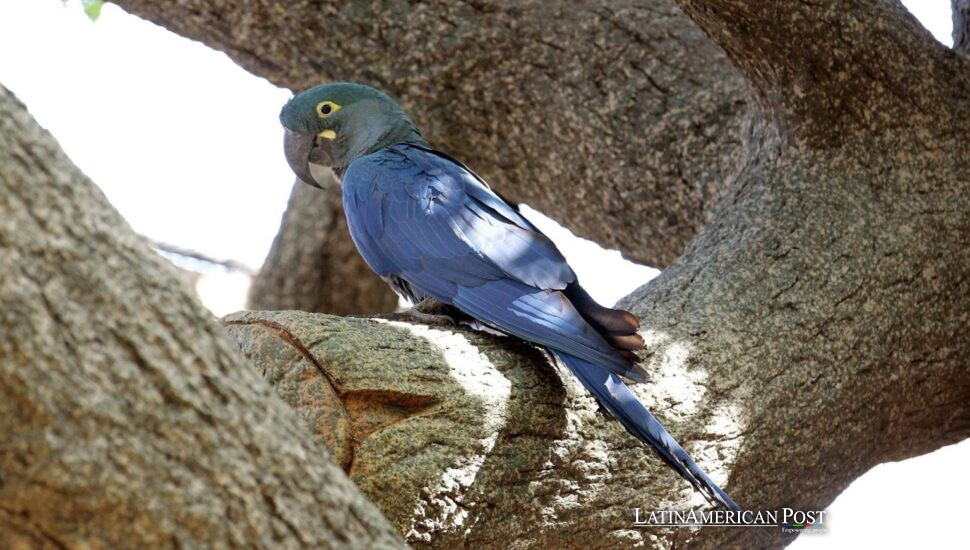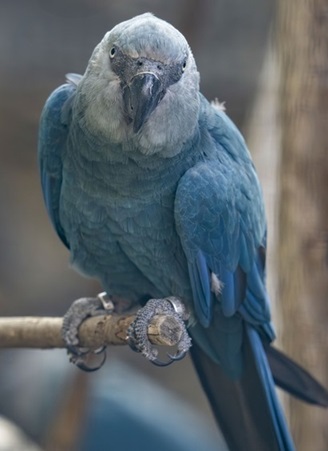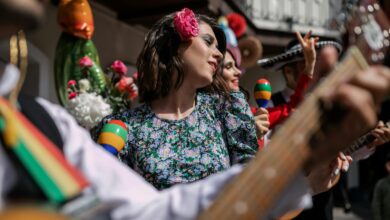White Feathers in the Blue Sky: A Virus Threatens Brazil’s Wild Spix’s Macaw Comeback

In Brazil’s sun-bleached northeast, where the Caatinga stretches in thorny silence, the return of the Spix’s macaw was meant to be redemption made visible—a blue flame reborn from extinction. Then, in May, field workers noticed the impossible: white feathers streaking the turquoise. What should have been a miracle of flight suddenly carried a warning.
A Fragile Return Meets a New Threat
The scrublands of Curaçá, Bahia, have become a sanctuary for sound. Each morning, the cries of macaws echo over the dry riverbeds—a music that hadn’t been heard in the wild for more than two decades. Locals had begun to believe the impossible was happening: nests filling, hatchlings crying, the ghosts of the past replaced by wings in motion.
That fragile hope cracked this spring when BlueSky, the nonprofit managing the Curaçá breeding center, reported that seven Spix’s macaws tested positive for circovirus. This pathogen causes beak and feather disease. One of the infected was a wild-born chick; six others were juveniles preparing for release. The virus can cripple parrots by deforming feathers and beaks and stripping away their immunity.
Every bird in Curaçá is precious—there are fewer than two hundred Spix’s macaws left on the planet—so even one infection feels like an alarm bell. But the discovery rattled scientists for another reason. Circovirus isn’t native to South America. Before this year, it had never been found in a wild bird anywhere in Brazil. That made containment a race against time, not only to save the Spix’s but also to protect the region’s other parrots, parakeets, and blue-winged macaws that share its trees.
The trail of suspicion led halfway across the world. In January, a bird at a German breeding center preparing to ship macaws to Brazil had tested positive for the same virus. The Association for the Conservation of Threatened Parrots (ACTP)—which owns about half of all existing Spix’s macaws—retested the bird and declared it healthy. Still, Brazilian officials were never informed of the initial positive result, according to an investigation by the country’s biodiversity agency, ICMBio. By the time the 41 birds arrived in Brazil, the virus may have traveled with them.
Emergency Declared, Cooperation Frays
When the Curaçá positives were confirmed, ICMBio declared a sanitary emergency, dispatching veterinarians and biologists and, later, federal police. What they found was less a unified conservation project than a fractured alliance.
“Dealing with BlueSky and ACTP during this process has not been easy,” said Cláudia Sacramento, ICMBio’s wildlife disease coordinator, in an interview with Mongabay. She described “omission and resistance” from the facility’s management, accusing them of concealing information about the earlier German case and downplaying the risk to other species. “Their answer was always that circovirus poses no danger to Brazilian fauna,” she said. “That position is selective and incomplete.”
Over three visits between June and September, ICMBio’s team collected samples from 92 Spix’s macaws and nearby blue-winged macaws, swabbing nests and trapping wild birds to check if the virus had escaped captivity. Evelyn Pimenta, a veterinarian from the University of Brasília who joined the mission, described an unsettling scene. “The structure was large and well built,” she told Mongabay, “but several birds showed signs of stress—missing feathers, broken quills.” She noted “inconsistencies in biosafety protocols,” including medications given without veterinary oversight and invasive handling that could spread pathogens.
Free-flying macaws, meant to symbolize freedom regained, fluttered with patchy plumage. One had a crooked beak. None of these signs confirmed circovirus—but in a facility fighting an outbreak, they painted a worrying picture.
Inside the Breeding Center, a Clash Over Control
Behind closed doors, the crisis exposed deeper fractures. An anonymous veterinarian who formerly worked at Curaçá told Mongabay that management often dismissed disease warnings. When a wild-born chick showed abnormal white feathers, he said, “The ACTP team captured it and placed it with birds ready for release without knowing what was wrong.” His requests for diagnostic tests were waved away. Early testing used pooled samples—five birds per swab—so when the virus appeared, the team didn’t know which birds were sick.
He described a hierarchy where veterinarians were barred from key areas, including hatcheries, even as VIP guests were allowed to handle newborn chicks. “It was a contradiction,” he said. “Access for show, not for science.”
ACTP rejects the accusation. Scientific coordinator Cromwell Purchase told Mongabay the German bird “never produced a confirmed positive result,” arguing that a weak first test followed by two negatives was being misrepresented. He accused ICMBio of being “office-bound” and hostile to field professionals. The notion of recapturing free-flying macaws for testing, he said, was overreach: “It’s possible the virus is already endemic in Brazil—or that it’s a fabrication that doesn’t exist at all.”
BlueSky’s statement was equally defiant. The organization said all imported macaws were disease-free and that Curaçá follows strict biosecurity rules. They insisted any limits on government access were meant to protect the birds, not hide evidence.
To veteran ornithologist Luís Fábio Silveira, such arguments miss the obvious. “Curaçá has been studied for decades, and no case of circovirus was ever recorded until the arrival of these macaws,” he told Mongabay. “The only new variable here is them.” Testing free-living birds, he said, is not persecution but “imperative for the project’s safety.”

Health First, or Hope First?
The fight over testing masks a larger moral question: when does protecting hope endanger it? The Curaçá project has become a symbol of Brazil’s ability to right an ecological wrong. Capturing the birds again to take blood and swabs feels, to some, like betrayal. To others, it’s the only way to protect everything they’ve worked for.
“Who wants these macaws back in nature? Brazil, the Brazilian people—it is our patrimony,” Sacramento told Mongabay. “But they must return healthy.” When BlueSky asked a court to block ICMBio’s capture order, a federal judge denied the injunction, affirming the government’s duty to test and quarantine as needed.
At dawn, the Caatinga is quiet except for the wind and the pulse of wings. A turquoise arc crosses the sky, dazzling against the white glare—and somewhere in that blur may be a virus invisible to the naked eye. The Spix’s macaw, once erased from Brazil’s skies, is again at the mercy of human decisions: whether to test or to trust, to pause or to push forward.
Also Read: Teotihuacan’s Whisper: Can a Reconstructed Tongue Finally Unlock the City of Gods?
If the comeback is to hold, it will require more than breeding and release numbers. It will demand transparency, cooperation, and humility—the courage to slow down long enough to find the truth behind a few white feathers because the story of the Spix’s macaw is no longer just about bringing a bird back from extinction. It’s about proving that, when the miracle finally happens, we know how to keep it alive.




